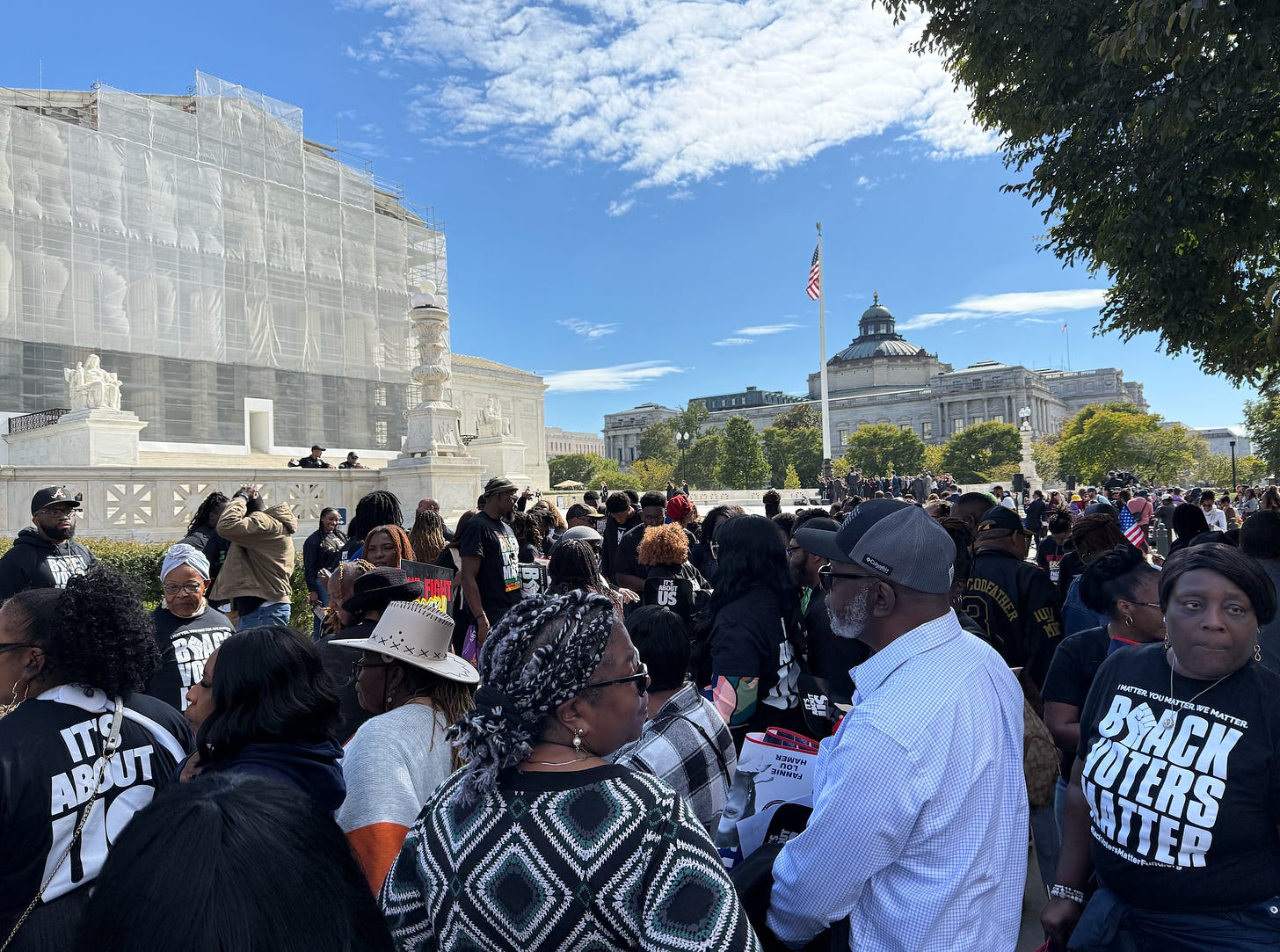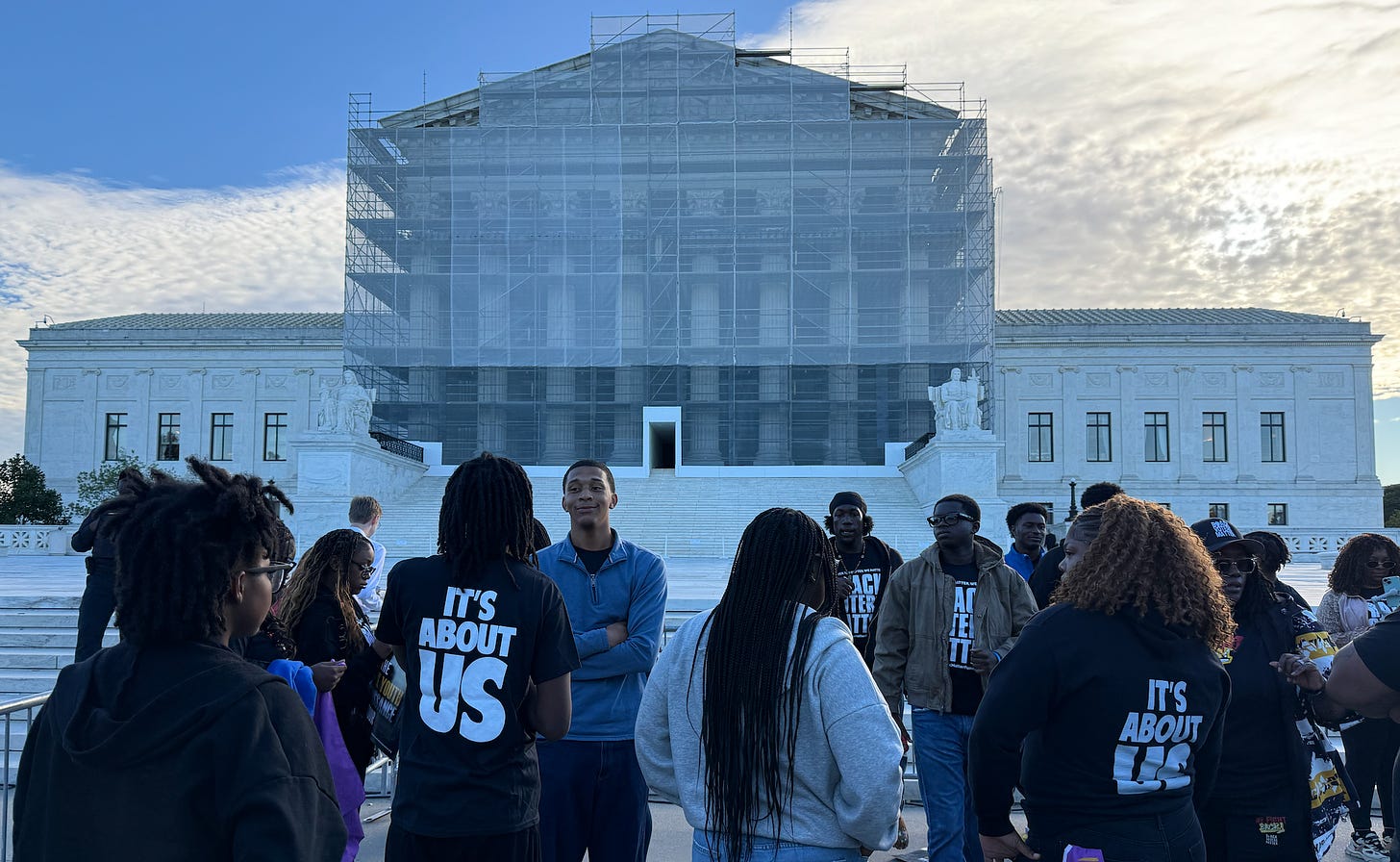Supreme Court likely to further diminish — but not end — Voting Rights Act cases
A majority of the justices didn't appear willing to hold that all "race-based redistricting" is unconstitutional, as Louisiana wanted. But how they'll get there was unclear.
On Tuesday, after two-and-a-half hours of arguments from four lawyers, the U.S. Supreme Court appeared likely to further restrict the power of the Voting Rights Act to remedy discrimination — but a majority also appeared unwilling to declare all “race-based redistricting” unconstitutional, as Louisiana had asked the court to do.
By time the last of the four lawyers to present arguments in the case over Louisiana’s congressional map was concluding his time before the justices, Justice Amy Coney Barrett had pushed the constitutionality question to the side.
Instead, Barrett asked Hashim Mooppan, the principal deputy solicitor general at the Justice Department. whether the court even needed to make a “modification” of the nearly 40-year-old test for considering vote-dilution claims under Section 2 of the Voting Rights Act. Could DOJ’s proposed path forward, she asked, instead just be seen as a “clarification” of that test, the Gingles test?
With one exception, Mooppan said it could, and even that was just the sort of tweaking of earlier opinions that the court does — which prompted an echo from Justice Elena Kagan, who had issued the opinion “tweaking” an earlier precedent that Mooppan had mentioned.
DOJ’s path would indeed make vote-dilution cases — cases where parties argue that a redistricting map illegally dilutes a minority group’s opportunity to elect the candidate of their choice — more difficult to prove and win, but it would be a better path for those seeking to maintain the power of the VRA than many expected going into arguments.
Throughout the arguments, there were repeated questions about how far the court needed to go in to case — Justice Ketanji Brown Jackson was laser-focused on the difference between a remedy ordered in a case and the actual requirements of Section 2 — and whether the procedural posture was important to how the court should view the case, leaving the specific outcome unclear.
Although it wasn’t clear what specific reasoning would ultimately control the outcome — and, with that, what guidance, if any, the Supreme Court would give to state lawmakers and lower courts — it ultimately looked likely that the court would not end the use of Section 2 in vote-dilution cases altogether as a constitutional matter.
And though a trio of justices were focused on what they viewed as the potential “discrimination” of majority-minority districts created as a result of Section 2 litigation, Janai Nelson, the president and director-counsel of the NAACP Legal Defense Fund, put it most simply in defending the civil rights law.
“Section 2 is addressing a preexisting problem,” she told the court. “It is not producing it.”
In June 2023, a 5-4 Supreme Court upheld — and strongly reaffirmed — the use of the Gingles test for vote-dilution claims in a case over Alabama’s map. The recent nature of that decision — combined with the nearly 40-year-old pedigree of the Gingles test — did create a sort of “coming at you from both sides” problem for those seeking an end to the Gingles test.
Chief Justice John Roberts reiterated in his opinion for the court in Allen v. Milligan, the Alabama case, what the Gingles test is, as I described at the time:
The minority group at issue has to be “sufficiently large and [geographically] compact to constitute a majority in a reasonably configured district”; “politically cohesive”; and be able to show that “the white majority votes sufficiently as a bloc to enable it . . . to defeat the minority’s preferred candidate.” If those “preconditions” are met, challengers must also then show that, in consideration of the “totality of the circumstances,” the “political process is not ‘equally open’ to minority voters.“
As Justice Sonia Sotomayor told Mooppan on Wednesday, ”Whatever mistakes we have in Gingles, Congress has had 40 years to fix them, and it hasn’t done it,” addressing a key reason why the court generally would not overturn a case deciding a matter of statutory interpretation — as opposed to constitutional interpretation.
Later, Barrett — who had dissented in the 2023 case — echoed that, noting that “Gingles is a 40-year-old precedent” and that it would be a “[b]ig ask to change it.”
And yet, the question was before the Supreme Court because the court asked for it in the winding Louisiana case that involves several conflicting lawsuits over the interplay between the Voting Rights Act and constitutional equal protection guarantees.
After Section 2 vote-dilution litigation brought by Black voters and backed by civil rights groups resulted in a preliminary injunction that led Louisiana to pass S.B. 8 — containing two majority-minority districts — other non-Black parties sued, claiming that the new map violated the Equal Protection Clause for white voters. They won below, bringing the matter to the justices — who allowed S.B. 8 to go into effect for the 2024 election before hearing the case over the map in March 2025.
The justices, however, did not resolve the Louisiana redistricting case last term. Instead, the court set the case for reargument this term — with Justice Clarence Thomas writing a rare dissent to such a move, arguing that the court had a responsibility to resolve what he called “the intractable conflict” between the court’s Section 2 jurisprudence and the Fourteenth Amendment. Over the summer, the court proposed the question Thomas suggested must be addressed, asking the parties to brief “[w]hether the State’s intentional creation of a second majority-minority congressional district violates the Fourteenth or Fifteenth Amendments to the U. S. Constitution.“
In responding to that request, Louisiana Attorney General Elizabeth Murrill, led by Louisiana Solicitor General Benjamin Aguiñaga, took Thomas up on his proposal — despite previously having defended the map against the constitutional challenge. “Race-based redistricting is fundamentally contrary to our Constitution,” the state’s new brief argued. “Over and over again, the federal courts have refused to hear us.”
The non-Black challengers who fought Louisiana’s S.B. 8 map argued that Section 2 “cannot be justified by current needs” and that the remedy of ordering majority-minority districts is, as Edward Greim argued for them Wednesday, nothing less than “widespread stereotyping of American voters based on race in violation of the Fourteenth and Fifteenth Amendments.”
DOJ, while leaning in that unconstitutionality direction in the first part of its brief, also proposed that the Supreme Court “should modify Gingles to align with the statutory text and avoid constitutional problems.”
It was that modification that Barrett addressed — and then proposed scaling back to a “clarification” — on Wednesday.
Mooppan said the three points they were arguing need modified are the “reasonably configured“ districts precondition, how “racially polarized voting“ was considered, and the confines of the “totality of the circumstances“ inquiry. The second and third, he said, could be considered clarifications, but he acknowledged that the “reasonably configured” districts argument would be a modification because DOJ is asking that challengers be required to show that they can offer a “superior” map.
As Nelson responded for the original set of Black challengers whose lawsuit led the state to pass the S.B. 8 map — and whose brief argued that the new case should fail on all fronts — even DOJ’s suggested “modification” is unnecessary.
“My opponents here have not done the labor of showing that precedents should be overturned,“ she said in her rebuttal. “I would say that there’s no record to support that in this case and this Court would be remiss to not require that if it is entertaining any significant modifications of Section 2.“
The difficulty of counting to five in the case — finding five votes for one position that could become the court’s opinion — was ever-present Wednesday.
Justices Clarence Thomas and Neil Gorsuch were solidly in the camp of siding with the Louisiana and non-Black challengers’ constitutionality arguments, Gorsuch, for example, insisted repeatedly that remedial maps in Section 2 cases sometimes intentionally “discriminate on the basis of race.“
Nelson, aptly, put the issue in context:
I don’t endorse the concept of discriminating on the basis of race. If discrimination has been established under Section 2 and a state determines that it needs a very precise incision of race in order to remedy that Section 2 violation, then Section 2 and this Court’s precedent supports that.
Justice Sam Alito, meanwhile, was largely focused on the implications of the Supreme Court’s 2019 decision holding that partisan gerrymandering claims are nonjusticiable for the Gingles test. As he asked Nelson, in light of the decision, “[I]sn’t seeking partisan advantage also an objective that a legislature may legitimately seek?“
As Nelson simply noted in response, though, “Not if it comes at the cost of the equal protection principle and the Fifteenth Amendment’s prohibition on race discrimination in voting.“
Of course, the Supreme Court had just in 2023 criticized and ruled against “Alabama’s attempt to remake our §2 jurisprudence anew” on several similar grounds to those raised by Louisiana, the non-Black challengers, and Gorsuch on Wednesday.
For his part, Justice Brett Kavanaugh — who had joined part of Roberts’s opinion in 2023 — seemed to notice, starting his questioning immediately following Nelson’s exchange with Gorsuch by noting, “I guess the hang-up there is the word ‘discriminate,’“ and adding that strict scrutiny still applies.
Kavanaugh’s focus Wednesday was instead an issue he had raised in the 2023 case in his own concurring opinion. As he put it Wednesday, it was the question of “the temporal limit“ on Section 2 or, at least, on race considerations in remedies to Section 2 cases.
Pushing back on that in a question to Mooppan, Kagan said that “this is not a kind of Shelby County thing” — referencing the court’s 2013 decision striking down the “preclearance” formula used until then in enforcing Section 5 of Voting Rights Act — “where one could say that Congress had acted and 50 years later, you know, the conditions on the ground might have changed.” This is different, she said, because Section 2 and Gingles require asking “whether … current conditions show vote dilution.“
As Jackson reiterated throughout the arguments in response, she saw one key aspect of arguments in the case as a misdirected focus.
“Section 2 is not a remedy in and of itself,” she said to Nelson early in the argument. “It is the mechanism by which the law determines whether a remedy is necessary.”
Barrett, meanwhile, asked about the procedural posture of the underlying case that led to S.B. 8 and whether the “litigation risk” under Section 2 in a case that has not been concluded still provides the “compelling interest” that the state would need to have to pass a map in which race is a consideration. “Because it was a preliminary injunction, and Louisiana, of course, argued there that, no, it wasn’t a violation of Section 2 to have those maps,“ she noted.
“It is still a compelling governmental interest,” Nelson told her.
In a reminder of the very real effects of these cases and those interests, Rep. Cleo Fields, the Black man elected to represent one of those majority-minority districts in 2024, was in the Supreme Court’s gallery on Wednesday watching the arguments.





Alito is all wet. The fact that the court held in Rucho held (wrongly) that partisan gerrymandering is a political question, is not the same that partisan gerrymandering is legitimate, much less that partisanship is a compelling state interest that would justify discrimination against Black voters.
“Race-based redistricting is contrary to our Constitution.” Know what wasn’t contrary? Slavery. Reducing African Americans to 3/5 humanity. Will Plessy be brought back too? So much effort to gentrify racism.